MileValue is part of an affiliate sales network and receives compensation for sending traffic to partner sites, such as CreditCards.com. This compensation may impact how and where links appear on this site. This site does not include all financial companies or all available financial offers. Terms apply to American Express benefits and offers. Enrollment may be required for select American Express benefits and offers. Visit americanexpress.com to learn more.
Note: Some of the offers mentioned below may have changed or are no longer be available. You can view current offers here.
I originally wrote this series in 2012. As it has turned out to be quite popular, I am in the process of updating it to reflect current information for 2016.
“Top 10 Things to Do, See, and Eat in Peru” Series Index
- Top 10 Things to Do, See, and Eat in Peru: Prologue
- Top 10 Things to Do, See, and Eat in Peru: #1, Machu Picchu (this post)
- Top 10 Things to Do, See, and Eat in Peru: #2 & 3, Sacred Valley and Amazon Rainforest
- Top 10 Things to Do, See, and Eat in Peru: #4 & 5 Lake Titicaca and the Colca Canyon
- Top 10 Things to Do, See, and Eat in Peru: #6 & 7, Cuzco and Lima
- Top 10 Things to Do, See, and Eat in Peru: #8, 9, and 10; Iquitos, Mancora, Arequipa & Some Honorable Mentions
1. Machu Picchu at Dawn
Some sites are so hyped, you think they can’t possibly deliver. Machu Picchu is one such site, but it has delivered for me three times. The key to Machu Pichhu: for the most memorable, awe-inspiring trip to Machu Picchu, do not go on a package tour, and arrive at dawn.
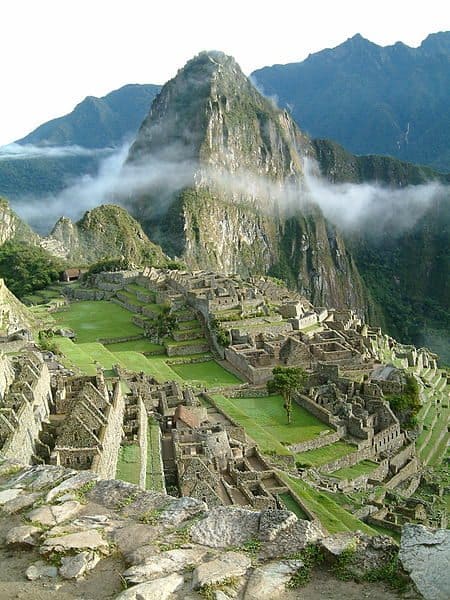
The Logistics of Machu Picchu
Buy a ticket online at http://www.machupicchu.gob.pe/ (Clicking on the Union Jack will give you a mostly-English Spanglish page.) One entrance ticket to just Machu Picchu is $38. You don’t have to buy the ticket months in advance. There aren’t any tickets available for the following week, but if you look one week out there’s tons available (416 on July 29). Granted, this is the high season, so if you’re buying a ticket in the low season you probably don’t need to buy with much advance notice at all. But you should buy the tickets when you know what day you’ll be at Machu Picchu because there is a strict limit of 2,500 visitors per day.
To get to Machu Picchu, you have to get to Cuzco. That’s easy enough by bus from Arequipa or Puno or by air from Lima for 4,500 Avios and a few dollars tax each way on Latam Airlines (although I would check the price of cash tickets, I see them now for $78 one way).
From Cuzco, you have to get to Aguas Calientes, the city at the base of Machu Picchu. You can only do that by train…
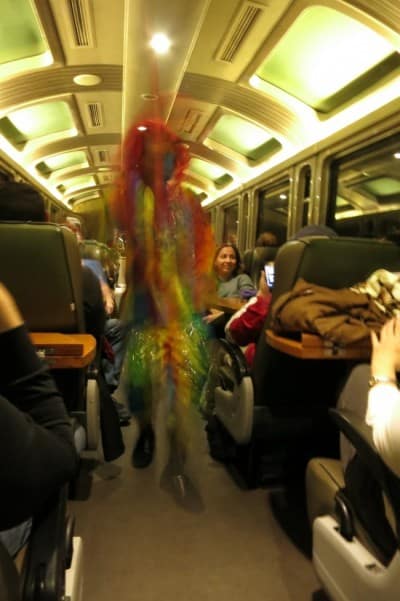
…or by hiking the Inca Trail. More on that at the bottom of this post.
Alternatively you can take the train from Cuzco (technically the station is called Poroy), Ollantaytambo, or Urubamba. I recommend taking it from Ollantaytambo but returning to Cuzco. Taking the train from Ollantaytambo is cheaper, and since you’ll want to see Ollantaytambo (see #3), it saves you from backtracking. It’s like an open jaw train ticket.
You can buy your tickets online at https://www.perurail.com/en/. I recommend buying the train ticket for the afternoon or evening before going to Machu Picchu and the latest return you can get on the day of your trip to Machu Picchu. There is not much to do in Aguas Calientes, so you don’t need to spend extra time there (although I do recommend Indio Feliz for a meal, and the hot springs are OK).
Example: If you want to see Machu Picchu on August 15, buy the Ollantaytambo – Machu Picchu ticket for the afternoon or evening of August 14, and buy the Machu Picchu – Cuzco ticket for the last train on August 15.
From Aguas Calientes, you have to get up the mountain to Machu Picchu. You can walk it or take the bus. The bus costs about $8 each way. I take the bus in the morning because the buses start at 5:30 AM, when I don’t have the strength to walk an hour plus up a steep hill at high altitude. But if you like hiking and saving $8, I think the walk back is pleasant.
When you get into Aguas Calientes on your afternoon train, go buy a bus ticket immediately from the bus departure area for the earliest departure time you can snag; buses start at 5:30 AM.
Why not do a packaged tour of Machu Picchu?
The vast majority of packaged tours get to Machu Picchu about 10 AM and leave in the mid-afternoon. Not only do you miss the incredible sun rise over the mountains, but you miss the tranquility of being at the site with only a few dozen people. You will not want to feel rushed or herded. You will want to explore Machu Picchu at your own pace.
So I strongly recommend seeing Machu Picchu independently and being up the mountain as early as possible. That will give you a few hours to relax and explore on your own. Then right at 10 AM, as the place will become flooded with visitors, you make your escape up Huayna Picchu.

Huayna Picchu (or Wayna Picchu) is a mountain overlooking Machu Picchu with incredible views and photo ops. The hike is about one hour up. It’s not particularly tough, but I had to stop several times to catch my breath because of the altitude. If you are in moderate physical condition, you can handle it.
Important Note about Huayna Picchu: Only a limited number of people are allowed up Huayna Picchu in two groups, one that is allowed to enter between 7 and 8 AM, and another that can enter between 10 and 11 AM. I strongly recommend being in the 10 AM group, as the first time slot is a better time to be at Machu Picchu than the second.
To get a slot in either group, you have to purchase it in advance as part of your ticket. These tickets are much harder to come by than just Machu Picchu tickets. A scan of the ticket website shows that combined Machu Picchu/Huayna Picchu tickets should probably be purchased at least a month in advance.
A ticket just to Machu Picchu is $38, while the Machu Picchu/Huayna Picchu combined ticket is $45.
Guides: I went once with a guide, but I hiked Huayna Picchu during his tour. The other times I was without a guide. That was fine for me. Any guide book will have information as good as most guides.
Outside the ruins are a number of willing guides. Make sure you negotiate the price in advance and clarify that that is the total price. “That was the price per person!” is a classic trick. No guarantee on quality. The best guides and most expensive are in Cuzco.
Getting there: 4,500 Avios from Lima-CUZ on Latam (or a cheap cash ticket), train to Aguas Calientes, bus to ruins
Hotels: Aguas Calientes has all manner of hotels in every price range. There is an $1300/night hotel at Machu Picchu itself, the Belmond Sanctuary Lodge. If you have the money for one room there, you probably have the money to put your favorite travel blogger up for a night in another room!
Time needed to visit: 6 hours including Huayna Picchu
When to go: The best weather coincides with peak season of June to August. December through April is the rainy season, but the crowds are gone, and Machu Picchu looks incredible shrouded in clouds. My pick is February, when the Inca Trail is closed, so there are fewer people at Machu Picchu than any other time. But if you want do a trek, that’s a different story.
Trekking to Get to Machu Picchu
An Aside by Sarah Page
I’m going to chime in here as I traveled to Peru last year and hiked the Salkantay trail to Machu Picchu over the course of four days and three nights. It was a fantastic experience that I will absolutely never forget, and I highly recommend it. I also recommend that you be in relatively good shape though if you do one of the longer treks like this, as it is a lot of hiking over the course of several days.
Some of the popular trail options include:
- Inca (the one you’ve probably heard of, by far the most popular)
- Salkantay
- Lares
- Vilcabamba
- Cachicata
You also have options when it comes to the length of the trek you choose– packages are offered for anywhere from one day to two weeks on varying trails.
You have to have a permit to hike the Inca trail, as tickets to enter are strictly capacity controlled by the Peruvian government. They sell out months in advance (especially for the high, dry season). You can check availability for the Inca trail here. You also must do the trek with a guide authorized by the Peruvian government (they should take care of the permit for you). I do not think the rest of the trails I named above require that you have a permit to enter, nor do they require you be accompanied by a guide.
There are packages where you trek with a group (like I did) or you can hire a private guide.
If you’re going to do a trek, it’s probably wiser to choose dates during the dry season (June to August). I love hiking, but hiking when it’s wet and cold (the Salkantay trail mounts peaks that are above the snow line) can be miserable. There will be more people on the trails and at Machu Picchu at this time of course.
Here are some pictures from when I hiked the Salkantay.
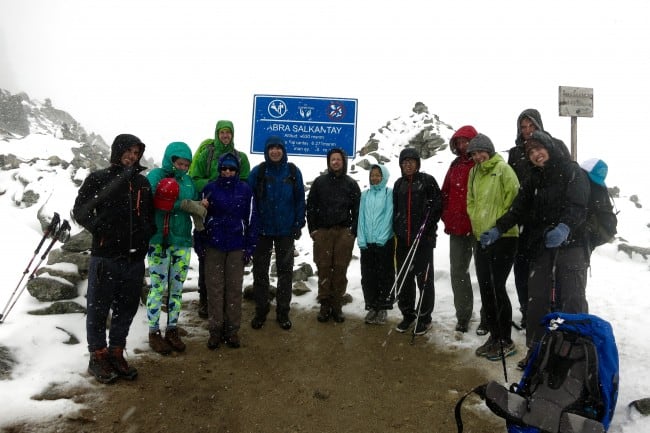
We only look a little bit cold, right? On the Salkantay you reach the highest summit on the first day: approximately 15,000 feet. The rest of the trail is much more amiable. You actual hike through multiple microclimates and are walking through coffee and banana plantations by the end– I found the diversity to be the most interesting thing by far.
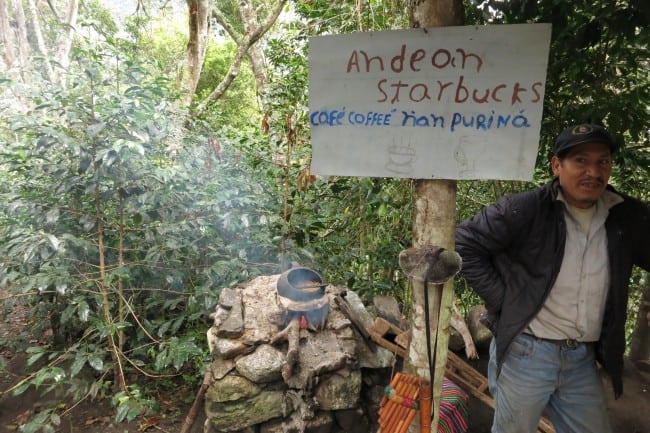
I used a tour operator named Enigma and also recommend it highly. The guides were super knowledgable and friendly, and the food was impressive. Every time the group arrived to a destination for a break or to camp for the night, the guides/staff had already set up a tent with table and chairs (as well as a separate tent for themselves in which they erected a make shift kitchen), where hot drinks and delicious meals were served.
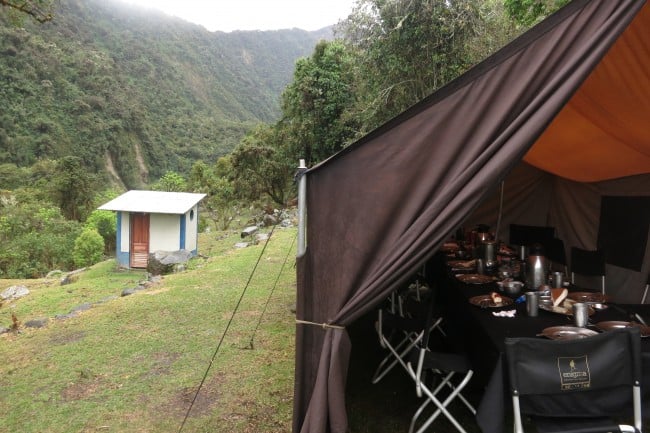
Pro tip: If you hire a porter (donkey) to carry any of your things, make sure you don’t put anything in that pack that you might want with you on a daily basis as the donkeys walk at a different pace from the people. And if you’re hiking the Salkantay especially, wear waterproof boots. I learned those lessons the hard way.
Bottom Line
If there is one thing you should not miss when you go to Peru, it’s Machu Picchu. It lives up to its reputation.
Want some extra tips? Mountain IQ has a thorough roundup of logistical info including a sample itinerary of the Inca Trail.


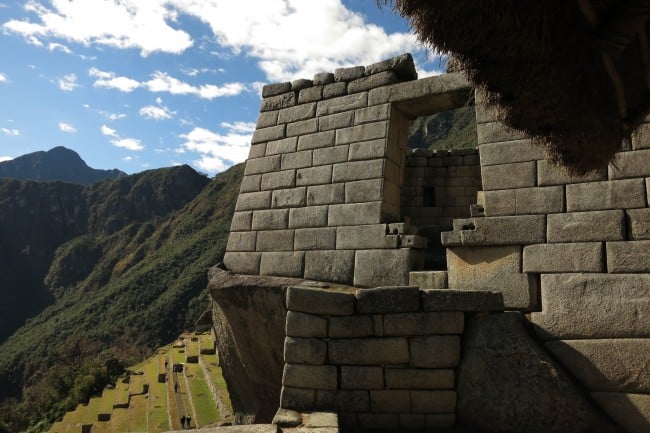
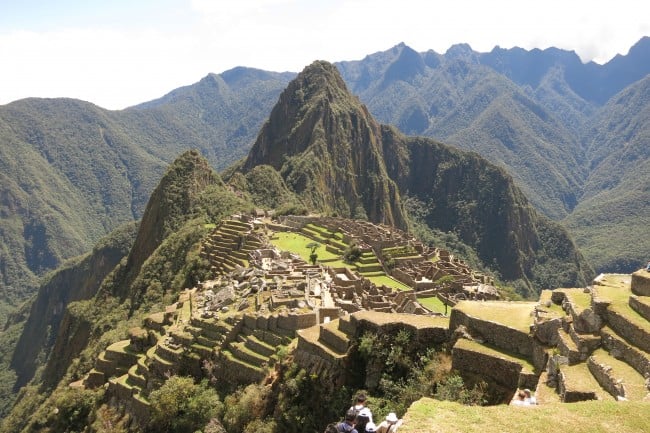
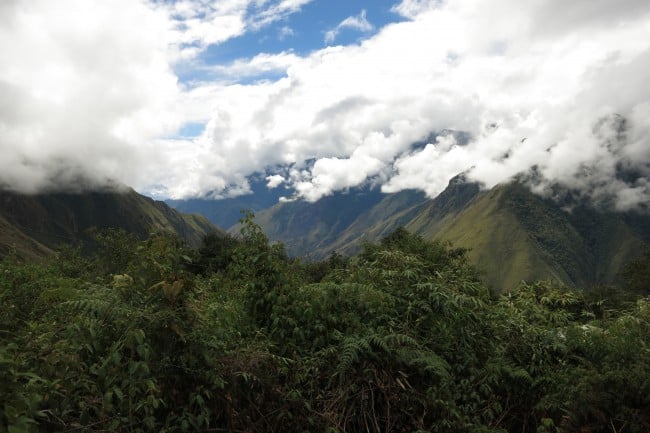
I’ve been reading your reports since we’re MP bound later in the year.
You will enjoy it.
Thank you for the superb Peru series! You should be contributing to one of the travel books as a side job. Is the US dollar widely accepted when travelling around Peru?
It is, but if you take dollars, you will get a much better rate changing them at the ubiquitous change shops than using the dollars directly. The exception is that many more expensive tours, hotels, etc are priced in dollars, not soles.
Good suggestions! Also, students with an ISIC card get 50% off the entrance fee to MP, which is a huge savings. The only problem is that you have to get the ticket in Aguas Calientes at the tourist office, but I was still able to get a ticket to Huayna Picchu the day before.
Loved the cashier saying (in Spanish), “this kid with a metal credit card (Sapphire Preferred) doesn’t look like he needs a discount.”
We are planning a trip to Machu Picchu this fall and your blog has been really helpful! Wondering if there is a travel guide book(s) you’d recommend for us?
[…] This shouldn’t be a surprise to anyone who has seen my Top Ten Things to Do, See, and Eat in Peru. […]
[…] This shouldn’t be a surprise to anyone who has seen my Top Ten Things to Do, See, and Eat in Peru. […]
[…] Machu Picchu, the Sacred Valley, and Lake Titicaca. I was partially inspired by Scott Grimmer of Milevalue, on his Peru trip reports, who says that Peru is his favorite country in the world. He’s got a great top 10, of which we […]
[…] I went over a little of Lima and Cusco in the first installment of my trip report. Unfortunately, we only had 7 days in Peru, and wanted to see several different sights, so I didn’t really get immersed that much in the cities. For more thorough looks at these places, check out Scott at Milevalue’s post about top 10 things to do in Peru. […]
Hey! Thanks so much for this great Peru review! Im going June 2 and have used it to plan my trip.
What is the best way to get to the Ollantaytambo train station? Thanks so much.
From where? In Ollantaytambo, you walk there. From Cuzco, you bus and taxi to Ollantaytambo to see the town before taking a train on to Machu Picchu.
Hi Scott,
I will be booking tickets for train and MP, do they all charge in USD or Local currency, should I just use any card which doesn’t charge foreign transaction fee?
I’m not sure, probably local currency. Just use a card with no foreign transaction fees, and you’re golden.
[…] Top 10 Things to Do, See, and Eat in Peru: #1, Machu Picchu […]
Loved this series. My wife and I definitely used it a lot on our trip. We climbed Montana instead of Huayna Picchu. It’s twice as tall, slightly less busy, and the most exhausting hike of my life. Like an hour and a half on a stair-stepper at high altitude.
I feel ya there! The altitude in that part of Peru can be killer. Worth it though.
As a travel doctor I would advise low dose Diamox for Cusco if there are no contraindications. Machu Picchu is at a lower elevation than Cusco and I had one patient who felt much better there than in Cusco- so if you choose not to take Diamox and feel funky in Cusco I would suggest continuing on to Machu Picchu- which follows traditional advice for altitude sickness- go down. If you can afford it I would advise staying at the Belmond Hotel Monasterio in Cusco- it is an old monastery and is sublime in the early morning hours. Agree with all Scott said and would add staying at Machu Picchu if it rains for the same reason- having Machu Picchu to yourself is special.
All good points. I took altitude medication as well when I was in Cusco (was there for a week before starting the Salkantay to make sure I had physically adjusted before engaging in such physical activity). I don’t remember the brand name I took, it was a South American brand, but it worked. I started taking it a couple days before arrival in Cusco and didn’t have any issues when I get there. And yes, Machu Picchu is a lower altitude, so that works out well.
Few need Diamox. My SO stopped taking it as she had reactions to the meds and immediately felt better. I didn’t take them at all and felt fine – just ensure you’re well hydrated and take it easy for the first few days. Unless you have underlying medical issues or are grossly out of shape, you should be fine. Most guides suggest a couple of days in Cusco is sufficient to acclimatize if you plan to hike the trails. The trails are harder than most sites suggest, so don’t expect an easy hike if you’re not in shape.
Agree, MP exceeds the hype. One of only two places I’ve visited that I can say that.
Best award value for hotel in Cusco is SPG Palacio del Inka (10K/night). Older property but atmospheric and in good location in old town. Tambo del Inka in Urabamba is a superb newer property and worth a stay if you have the time. Also excellent value at 10K/night.
Belmond’s Sanctuary Lodge at the entrance to MP is well worth the $ because of prime location being the only property at the top avoiding crappy Aguas Calientes (a tourist trap with few redeeming features other than being next to the train station). Can get no-view rooms for $450+taxes a night (about $495). If you can afford it, get a terrace view room. Property has stunning views and you don’t have to deal with the rabble on the buses. Also has nice gardens and day room to hang out if needed. Beware of getting rooms facing the front as they overlook the busy parking lot where all the tourist buses unload/load (buses start arriving early, so don’t expect to sleep in if you have one of those rooms – although they have great view of MP).
Disagree about getting the last trains to Cusco – those trains only have limited daylight and you won’t see much. Consider the 3:20 Vistadome train as you can enjoy the views on the way home thru Sacred Valley.
[…] Top 10 Things to Do, See, and Eat in Peru: #1, Machu Picchu […]
[…] Top 10 Things to Do, See, and Eat in Peru: #1, Machu Picchu […]
[…] Top 10 Things to Do, See, and Eat in Peru: #1, Machu Picchu […]